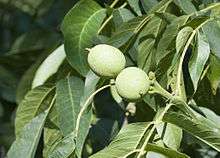Wet walnuts
 Shelled walnuts | |
| Alternative names | Walnut topping |
|---|---|
| Type | Dessert topping |
| Main ingredients | Walnuts, maple syrup or simple syrup |
|
| |
Wet walnuts or just walnut topping is a dessert topping made from walnuts and maple syrup.[1] Sometimes simple syrup, corn syrup, syrup,[2] sugar[3] or brown rice syrup[3] is used instead of (or used in combination with) the maple syrup. Wet walnut topping is similar in some respects to pralines, except that the walnuts are always served in syrup, rather than as individual pieces. Some commercial preparations of premade wet walnuts exist.[4]
Wet walnuts are most commonly served with ice cream and as a sundae topping.[4] They are often available as an ice cream topping at ice cream parlors in the United States.
Wet walnuts (United Kingdom) also refers to fresh walnuts which have not been dried for keeping. They are also called green walnuts. Fresh (wet) walnuts have been stated to pair well with some hard cheeses such as pecorino and Parmesan.[5] Some foods are prepared using wet walnuts as a primary ingredient, such as mhammara dip.[6]

See also
References
- ↑ Lebovitz, D. (2011). The Perfect Scoop: Ice Creams, Sorbets, Granitas, and Sweet Accompaniments. Clarkson Potter/Ten Speed/Harmony. p. 198. ISBN 978-1-60774-094-0. Retrieved February 6, 2015.
- ↑ Larsen, L. (2009). The Everything Potluck Cookbook. Everything®. F+W Media. p. 73. ISBN 978-1-4405-2111-9. Retrieved February 6, 2015.
- 1 2 Perillo, J. (2013). Homemade with Love: Simple Scratch Cooking from in Jennie's Kitchen. Running Press. p. 233. ISBN 978-0-7624-4723-7. Retrieved February 6, 2015.
- 1 2 Magazine, M.S.L. (2008). The Martha Stewart Living Cookbook: The Original Classics. Clarkson Potter/Ten Speed/Harmony. p. 407. ISBN 978-0-307-45335-8. Retrieved February 6, 2015.
- ↑ Segnit, N. (2010). The Flavor Thesaurus: A Compendium of Pairings, Recipes and Ideas for the Creative Cook. Bloomsbury Publishing. p. 294. ISBN 978-1-60819-313-4. Retrieved February 6, 2015.
- ↑ Saleh, N. (2012). New Flavours of the Lebanese Table. Ebury Publishing. p. 100. ISBN 978-1-4481-1876-2. Retrieved February 6, 2015.
External links
- Wet walnuts article from Everything2
- Recipe from the Martha Stewart website
- Wet walnuts. The Cottage Smallholder.
- Recipe from Recipezaar
- The Independent